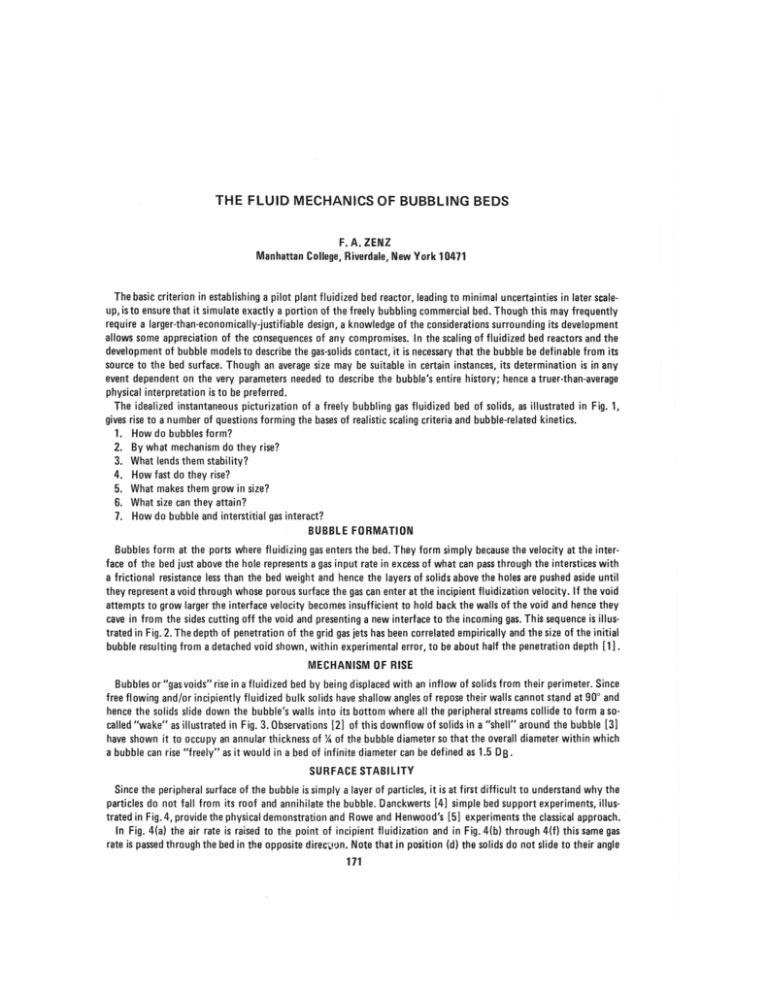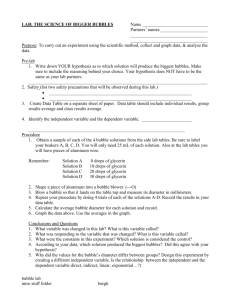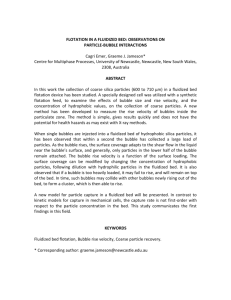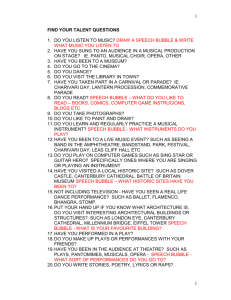THE FLUID MECHANICS OF BUBBLING BEDS
advertisement

THE FLUID MECHANICS OF BUBBLING BEDS
F.A.ZENZ
Manhattan College, Riverdale, New York 10471
The basic criterion in establishing a pilot plant fluidized bed reactor, leading to minimal uncertainties in later scaleup, is to ensure that it simulate exactly a portion of the freely bubbling commercial bed. Though this may frequently
require a larger-than-economically-justifiable design, a knowledge of the considerations surrounding its development
allows some appreciation of the consequences of any compromises. In the scaling of fluidized bed reactors and the
development of bubble models to describe the gas-solids contact, it is necessary that the bubble be definable from its
source to the bed surface. Though an average size may be suitable in certain instances, its determination is in any
event dependent on the very parameters needed to describe the bubble's entire history; hence a truer-than-average
physical interpretation is to be preferred.
The idealized instantaneous picturization of a freely bubbling gas fluidized bed of solids, as illustrated in Fig. 1,
gives rise to a number of questions forming the bases of realistic scaling criteria and bubble-related kinetics.
1. How do bubbles form?
2. By what mechanism do they rise?
3. What lends them stability?
4. How fast do they rise?
5. What makes them grow in size?
6. What size can they attain?
7. How do bubble and interstitial gas interact?
BUBBLE FORMATION
Bubbles form at the ports where fluidizing gas enters the bed. They form simply because the velocity at the interface of the bed just above the hole represents a gas input rate in excess of what can pass through the interstices with
a frictional resistance less than the bed weight and hence the layers of solids above the holes are pushed aside until
they represent a void through whose porous surface the gas can enter at the incipient fluidization velocity. If the void
attempts to grow larger the interface velocity becomes insufficient to hold back the walls of the void and hence they
cave in from the sides cutting off the void and presenting a new interface to the incoming gas. This sequence is illustrated in Fig. 2. The depth of penetration of the grid gas jets has been correlated empirically and the size of the initial
bubble resulting from a detached void shown, within experimental error, to be about half the penetration depth [ 1 ] .
MECHANISM OF RISE
Bubbles or "gas voids" rise in a fluidized bed by being displaced with an inflow of solids from their perimeter. Since
free flowing and/or incipiently fluidized bulk solids have shallow angles of repose their walls cannot stand at 90° and
hence the solids slide down the bubble's walls into its bottom where all the peripheral streams collide to form a socalled "wake" as illustrated in Fig. 3. Observations [2] of this downflow of solids in a "shell" around the bubble [3]
have shown it to occupy an annular thickness of % of the bubble diameter so that the overall diameter within which
a bubble can rise "freely" as it would in a bed of infinite diameter can be defined as 1.5 D B .
SURFACE STABILITY
Since the peripheral surface of the bubble is simply a layer of particles, it is at first difficult to understand why the
particles do not fall from its roof and annihilate the bubble. Danckwerts [4] simple bed support experiments, illustrated in Fig. 4, provide the physical demonstration and Rowe and Henwood's [5] experiments the classical approach.
in Fig. 4(a) the air rate is raised to the point of incipient fluidization and in Fig. 4(b) through 4(f) this same gas
rate is passed through the bed in the opposite direct 1 '^. Note that in position (d) the solids do not slide to their angle
171
172
THE FLUID MECHANICS OF BUBBLING BEDS
,••••••.
»••••••
•
•
%9
• « • • • *
.•
••
%••••••
0
•
•••••••••
, •••• •••*! •*"•* ••"% •••* *•"» •**• » * ^ •""*,• **"l • • • • • • • • » ^
:..j
L.J u~> t . ^ % . . * ••••• %-J» •••«* ••** i - - * •*• t « * • • *
••* /•• *• *• -""l A **# #•• .*• ••> ^s /"•• r
*J-L3LJ'-Li L_> Li- L} t-J £_*t-S i-3 L : LJ-<
Fig. 1 idealized Freely-Bubbling Gas Fluidized Bed
1978]
THE FLUID MECHANICS OF BUBBLING BEDS
173
=" i c
Vo
(0
(b)
(a)
L
1
2
i
i
V
p
'
'
mf
®
©
^
® S» <8
Vo
(d)
(e)
Fig. 2 Bubble Formation from Bed-Penetrating Gas Jets at the Grid Ports
174
THE FLUID MECHANICS OF BUBBLING BEDS
bubble - displacing
annular downflowing
"shell" of bed solids
\
..
*+**>*
wake
!j
"^-.-•'X
1.5 D B
Fig. 3 Bubble Rise via Displacement by Inflow of a Surrounding Down-Flowing Shell of Bed Solids
[APR.
1978]
THE FLUID MECHANICS OF BUBBLING BEDS
175
<f>
£&#&: (d)
(b)
Fig. 4 Bed Support Experiments of P. V. Danckwerts
176
THE FLUID MECHANICS OF BUBBLING BEDS
[APR.
of repose but instead are held at 90° and that on reaching (f) the bed is held up without solids falling from what is
now its lower side or conversely the upper surface of a bubble in a fluidized bed. When the surface of a bed is traversed by an incipiently fluidizing flow the particles cannot separate from each other. This not only explains the bubble's surface stability but also the integrity of the walls of a bed penetrating jet as in Fig. 2.
Rowe and Henwood carried out classical drag measurements which revealed that the drag on a downstream particle
is reduced due to the presence of an adjacent upstream particle. This simply means that a particle cannot fall from
the roof of a bubble because if it did then it would immediately be followed by the particle above it, and that by the
particle stili further above, etc., so that the entire mass or bed above the bubble would have to collapse as a unit. For
this to occur, the excess gas could not be passed through the bed unless the bed were physically held down or restrained at its upper surface.
VELOCITY OF RISE
The velocity at which bubbles rise in a gas fluidized bed has been measured photographically by several investigators. The results are in excellent agreement with what would be predicted for gas bubbles in liquids from the drag
coefficient versus Reynolds number correlations of such investigators as Van Krevelen and Hoftijzer [6] illustrated
in Fig. 5. Over the range of Reynolds numbers corresponding to reasonable size bubbles the drag coefficient is essentially a constant so that simple substitution shows that if gas density is small relative to the bed density:
CD
4gDB(pB - pG)
3pBV2B
4g_
3k
DB(PB-PG)
pB
or
VB = 4.01^DB .
This has been corroborated in experiments with freely bubbling beds.
Tarmy and Matsen [7] have shown that in slugging beds the full width of the downflowing solids shell (Fig. 3) is
restricted and the velocity of bubble rise then approximately Yz that in a freely bubbling bed.
BUBBLE GROWTH
That bubbles must grow by merger as they rise through the bed is obvious from the large and less frequent surface
eruptions relative to a much higher frequency of small voids initiated from a usual multitude of grid ports. Growth
by simple gas expansion resulting from the pressure reduction between bottom and top of a fluidized bed is generally
relatively insignificant.
From the solids inflow model [3] of Fig. 3 it is obvious that a bed must be exceptionally homogeneous to expect
the shell of downflowing solids around a bubble to be flowing at equal rate in every plane. Any bed non-uniformity
can cause a shift in the bubble shape or position. Merely the prior passage of another bubble could alter local densities or distributions so as to make bed solids in one local area more readily flowable in a given direction than the bed
solids in an adjacent area. The solids inflow model therefore obviates a simple mechanism of bubble merger. If two
bubbles get close enough that their shells of downflowing solids begin to interact, the touching shells will represent
a local downflowing stream of solids faced with more than one path to the nearest void. The stream could be squeezed
to the point of being insufficient to satisfy both bubbles and thereby drain off leaving no wall between the voids
and hence the appearance of a single bubble.
It is therefore readily acceptable that the idealized bubbling of Fig. 6(a) will lead to a situation as in 6(b) where
two bubbles of unit initial volume can merge into bubbles of twice this volume. Since larger bubbles rise more rapidly
these double volume bubbles will catch up and merge with other unit volume bubbles to yield bubbles of thrice the
initial bubble volume. These newer bubbles will rise even more rapidly and can catch up with bubbles of 1 or 2 times
the volume of the initial bubble resulting in bubbles of at most 5 times the volume of the initial bubble.The bubble
of five-fold volume can now catch up with bubbles of 1, 2 or 3 times the volume of the initial bubble resulting in
bubbles of at most 8 times the volume of the initial bubble as illustrated in Figs. 6(c) and (d). Carrying on this process of overtaking bubbles results in a sequence of maximum multiples of the initial bubble volume in which each
1978]
THE FLUID MECHANICS OF BUBBLING BEDS
1
1
177
•°o
T
— i —
|
I
ERIES BUB LING
r
CD
LBS,
1
K
1
^
sass #
St
mm
«
\
h
Ir
o
o
o
o
/ X
/
»
•
n
o
o
cr
CO
SIN GLE BUBBL
(f)
*HI
J o
o
^
/1
o
o
o
o
i
o
o
o
1
_L
q
- 6
o
o
o"
o
O
178
THE FLU8D MECHANICS OF BUBBLING BEDS
[APR.
(b)
(o)
£D
cs
dO
£D
O
o
<o
o
a>
o
o
o
o
o
o
a
o o
o o
o
o
o
a
o
o
°
O
o
o
o
0 J) JUL 0 JU
O
O
CD
O
O
o o o o o
o
0 Q 0 0 0 0
(c)
(d)
(ID o
(X> o
3
CD
o
o
£1}
o
2
o o o
o
I
o
£D
£D
O
o
CO
CD
<0
CD
°
<0
JUOJUUL
FIGURE 6. THE "CATCH-UP" MECHANISM OF BUBBLE GROWTH
1978]
THE FLUID MECHANICS OF BUBBLING BEDS
178
multiple is the sum of the two previous multiples. This sequence, illustrated in Fig. 7, is the well known "Fibonacci"
[8] series.
Since the levels at which the maxima exist represent the summation of the diameters of their forebearers and since
their diameters are proportional to the cube root of their volumes, it follows that the ratio of merged bubble diameter to initial bubble diameter is equal to the cube root of the number of initial bubbles consumed in the merger,
and also that the level at which the merged bubbles exists relative to the height (or diameter) of the initial bubble is
equal to the summation of the cube root of the number of initial bubbles consumed in the merged bubble. For the
case of the maximum size of merged bubble this is illustrated analytically in Fig. 7 and shown graphically in Fig. 8.
That the mechanism of Figs. 7 and 8 appears in good agreement with experimental observations is illustrated in
Fig. 9 where the empirical bubble growth relationships proposed by Chavarie and Grace [9],Werther [10],and Rowe
[11] are superimposed on the curve representing the Fibonacci series. In using Fig. 9 to determine the maximum
bubble diameter, D%, at any bed level, LB, above the grid it is necessary to determine the initial bubble diameter,
DBI, which could exist at the grid level as a result of individual or merged jets. Figure 9 must also not be extrapolated beyond the maximum attainable stable bubble size.
MAXIMUM STABLE DIAMETER
Danckwert's bed support experiments (Fig. 4) and those of Rowe and Henwood based on particle drag force measurements, demonstrated that a bed interface (and hence a bubble) should be fundamentally stable against collapse as
long as it is traversed by a superficial velocity equal to its incipient fluidization rate. Since the inflowing solids shell
volume usually far exceeds the incipient fluidization rate, there would appear to be no limit to the attainable bubble
size, or dome, apt to collapse. Presumably, if the dome cannot collapse amid free flowing bed solids then as the bubble grows it could only be limited by particles leaving the shell and being entrained into the bubble void. Such entrapment, or particle pickup, would be most likely to occur from the bubble walls as the result of the relative velocity between gas and surface particles at the interface. Since against the downward velocity of bulk solids the bubble
fluid (whether gas or liquid) rises at approximately an equal velocity, the relative flow of fluid past the particles at
the bubble wall is twice the shell or bubble velocity. Equating twice the bubble velocity to the particle pickup velocity allows calculation of the minimum bubble size necessary to stir up the solids interface and thus thwart bubble
appearance or growth. Since pickup velocity is approximately twice saltation [12], this is equivalent to equating bubble velocity to saltation velocity. This procedure has given results in reasonable agreement with a broad range of observations reported to date. For example 80 micron particles of sand fluidized with air could sustain a maximum
bubble diameter of the order of 24 inches whereas when fluidized with water the maximum bubble size would be
indiscernable. Sand particles 600 microns in diameter when fluidized with water would permit a maximum stable
bubble size of only % inch and 3,000 micron lead particles a water bubble of 7 inches.
BUBBLE GAS INTERACTION
The outside diameter of the shell of downflowing bed solids surrounding the rising bubble is the minimum reactor
diameter necessary to simulate free bubbling. In addition to simulating free bubbling hydrodynamically it may be
argued that gas permeation from bubble into surrounding bed should also be equalled. This only becomes significant
or controlling with coarse and easily permeated beds having a high incipient fluidization velocity. The gas permeation
or "cloud" diameter is calculable from the depth of gas flow at incipient fluidization velocity over the time interval
required for the bubble to rise a distance of one bubble diameter. Since the bubble rises at a velocity equal to 4 times
the square root of its diameter it follows that:
Thickness of gas penetrated "cloud"
Thickness of downflowing solids "shell"
=
m
f
^ ^
or since
"shell" O.D. = 1.5Z?B
_
"cloud" O.D. = DB + Q.Sy/DBVmf
In applying free shell or cloud criteria in scaleup or scaledown the relationship between bubble diameter and bed
depth is obtainable from Fig. 9 with the limitation of the system's maximum stable bubble size. Thus from grid design, operating superficial velocity, and fluid and particle properties, it is possible to calculate the initial bubble size
180
THE FLUID MECHANICS OF BUBBLING BEDS
[APR.
N * NO. OF BUBBLES OF
DIAM. DB-, MERGED
DB
_
OR
B.
N
13
DB|(H5£+3T)
%% ]™"> |
/
-
^
Fig. 7 Maximum Bubble Growth by the "Catch-Up" Mechanism
Resulting in a Fibonacci Sequence
£•1$*
Oft
1978]
THE FLUID MECHANICS OF BUBBLING BEDS
f
§•
""""
1
•
—J—^^-
T
—i
1—
^v
— t
o
o
1
L
1
I
1
I
h
m
Q
•J
|"
I
^
2\
CD
"1
3
o
I
\
1
m
©0
\
Mb
L™^
O
!- J
_ J L _ ™JL
1
!aa/9Q
-
i
1
1
182
1
-J
r
L.
THE FLUID MECHANICS OF BUBBLING BEDS
V.
_ — -
^^^
X
i
i
i
i """^"r^™"
i
i
[APR.
o
o
i
1
j
\
I
x\
L™J
'S
o
«J
r
-^
^
B
•&
ffl
1-
I
APPROX IMAT ION:
r
wv
\
in
CO
6
Nfc 3
4 \ XN
]
o
i
$
d *"
II
ml
o
m
\ \
L
i
i
i
i
,
^J^^^
O
Q4
1
in
u.
<
L««« n ju«
-J
\
ml o~
_J 1 Q
i-
o
00
\
+
IRS
h
-I
!a
o / Sa
L—
I
E
o
o
1978]
THE FLUID MECHANICS OF BUBBLING BEDS
183
at the grid, the maximum stable size, and the bed depth over which the bubbles may grow from their initial to their
stable diameter. Once having reached their maximum stable diameter any further unlikely mergers would also leadto
collapse, so that bubble diameter may be considered constant once having reached the stable size.
An unquestionably conservative approach to a minimal risk pilot plant reactor free of scaleup considerations would
suggest it equal the larger of either "cloud" or "shell" diameter surrounding the system's maximum stable bubble.
NOMENCLATURE
CJJ = Drag coefficient, dimensionless
DB
= Bubble diameter, feet
0Bi
= Bubble diameter at grid level
g
= Gravitational acceleration, 32.2 ft./sec. 2
Lg
= Bed depth, feet
P
= Grid jet penetration
Re = Reynolds number, dimensionless
l/g
= Bubble rise velocity, ft./sec.
Incipient fluidization velocity, ft./sec.
Vmf=
PB
= Bed density, Ibs./cu. ft.
PG
=
Gas density, Ibs./cu. ft.
REFERENCES
1.
2.
3.
4.
5.
6.
7.
8.
F. A. Zenz, Instn. of Chem. Engineers (London), Symp. Series No. 30, pp. 136-139 (1968).
J. S. M. Botterill, J. S. George, H. Besford, Chem. Eng. Prog. Symp. Ser. No. 62,62,1 (1966).
F. A. Zenz, Hydrocarbon Processing, 46, No. 4, pp. 171-175 (1967).
P. V. Danckwerts, Symposium on Fluidization held at A.E.R.E., Harwell, England, October 5,1959.
P. N. Rowe, G. A. Henwood, Trans, 'istn. Chem. Engrs. (London), 3 £ 43 (1961).
D. W. Van Krewelen, P. J. Hoftijzerr Chem. Engrg. Progress, 44, 529 (1948).
J. M. Matsen, B. L.Tarmy,£. E. P. Symp. Series 66, No. 101, pp. 1-7 (1970).
D. G. Wilde, Optimum Seeking Methods, pp. 3 0 - 3 1 , Prentice-Hall Pub. Co., Englewood Cliffs, N. J., 1964;
see also V. E. Hoggatt, Jr., Fibonacci and Lucas Numbers, San Jose State University.
9. C. Chavarie, J. R. Grace, /. & E.C. Fundamentals 14, pp. 75-78, May (1975).
10. J. Werther, International Fluidization Conference, Asilomar, California, June 15-20 (1975).
11. P. N. Howe,ibid, (in discussion of preceding paper).
12. F. A. Zenz, /. & E. C. Fundamentals, 3, No. 1, pp. 65-76 (1964).
Etantinttesl from page 170.}
Thus,
>ij-i
tk'Z-icr-WjZi).
k=i
k=i
Actually, the effective upper limit of this last summation is min. (ij) = m + 1. Therefore,
m "
m
^•=E('V)(^7i f c )-r( y ^)(/-V-J.
k=0
k=0
which shows that by is symmetric in / and /
Actually, the last summation may readily be evaluated by the Vandermonde convolution theorem, so that:
(1)
bij = ( 7 ^ 7 2 ) '
fora,,/
V
<n
'
B. As before, let Dn = Cn.Arn\ let c{] and d{j bfe the entries in the / ' * row and/* 2 column of Cn and Dn, respectively. Then
c
[Contmued on p. W ]
ij= {[!])>
j<i<2i-1






